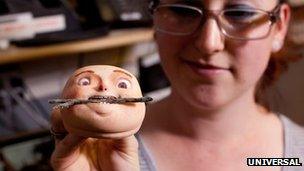ParaNorman producers make film using 3D colour printers
- Published

More than 31,000 facial expressions were printed for the production
Lights... camera... 3D colour printer. During the making of ParaNorman, a new stop-motion animation film released this week in the UK, four 3D printers were essential members of the crew.
Stop-motion is a traditional film-making technique that dates back to the 19th Century.
It involves using puppet models that are gently repositioned frame by frame to create the illusion of movement.
Traditionally, individual facial expressions would be sculpted by hand out of clay, but the producers of ParaNorman built up a library of 8,800 3D-printed faces for the main character alone, which could be used in various sequences, to give him about 1.5 million different expressions.
Production house Laika began experimenting with 3D printers in the production of its 2008 film Coraline, in which the lead character managed a comparatively feeble 200,000 expressions.
Time saving
British animation producers Aardman also used 3D printers in their recent film series The Pirates!
"All shapes need to be modelled on the computer before they are printed, but there's a time saving to be made in terms of animation on set," said Stuart Missinger, award leader on the Stop Motion Animation and Puppet Making course at Staffordshire University.
"It means the animator can literally pick and mix from a library of faces. But there's a seam line that runs where a mouth replacement slots in - it goes under the eye, across the bridge of the nose, across the temple.
"If the character has a beard, then the seam line is masked - but if it's visible it needs painting out in post production."
Mr Missinger's colleague, Daryl Marsh is senior lecturer in stop motion at the same university.
He admits the technique isn't to the taste of every potential animator.
"We try to push the students to try it out," he said.
"A lot of stop-motion is craft-based so they prefer working with their hands but there is some cross-over. When you've done it once, it makes sense - the first time it's confusing."
Printer power
Brian McLean is creative supervisor of replacement animation and engineering at the Rapid-Prototype department of Laika.
Laika says 3.77 tonnes of printer powder were used by the four printers working on ParaNorman.
They worked a total of 572 days, churning out faces from the lower eyelids down to the chins of the main characters.

Extra work was still involved once the faces came off the printers.
"There are super-glue and powder elements as part of the process. But the resin is liquid and it's sprayed by multiple heads in a given printer onto a water-soluble powder-based support material, which is the foundation for the entire process," said Mr McLean.
"Though they look like sugar cookies from the oven when they emerge, there's no residue when the support material washes away."
Sometimes the printers made mistakes - one scene in which two characters fall into each other and their faces blend was the result of a printer malfunction.
"The solution of purposefully printing the two characters' faces together came to us after a mistake from one of the printers, where a bunch of faces were printed on top of one another. Whenever there's a mistake in the process, we look at it and wonder, 'Could we utilize that?' In this case, it made for a cool effect."
Mr McLean also has a response for any purists who may believe the new technology takes the skill of stop motion away from its roots.
"The 3D Printers are the connection between computers and stop-motion," he said.
"Cutting-edge computer-generated starts it, and hand-made practicality - the signature of the stop-motion art form - finishes it."
- Published2 July 2012
- Published8 March 2012